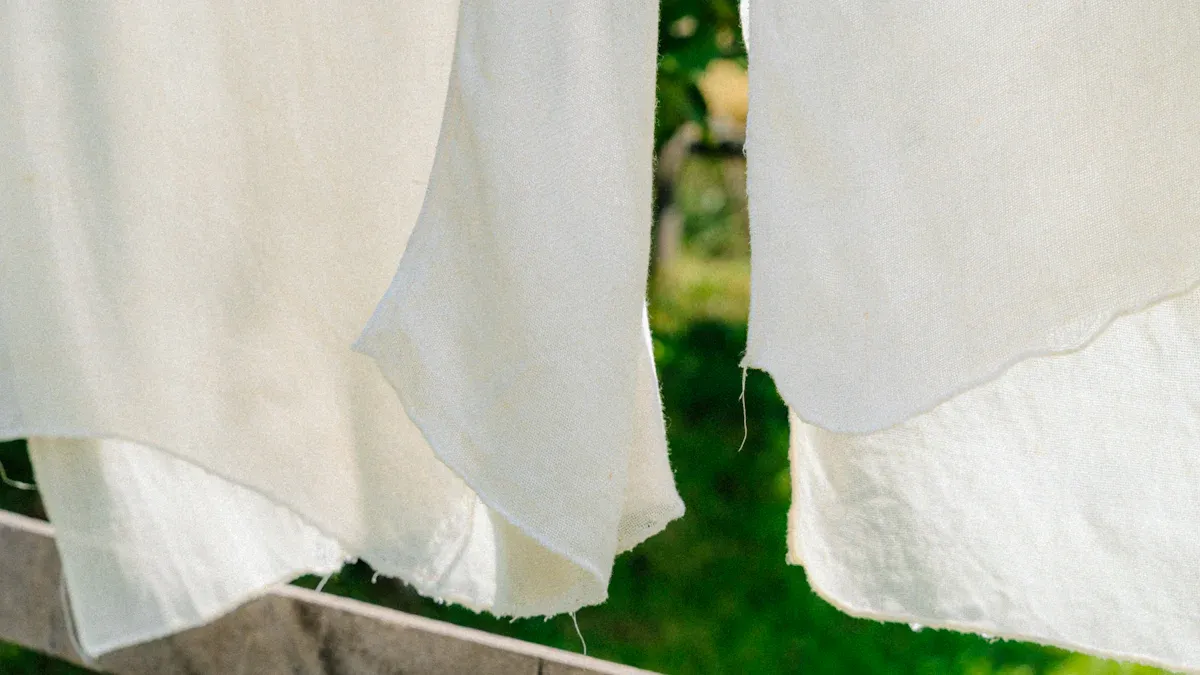
You can make a powerful choice for our planet with bamboo fabric. This incredible material comes from the bamboo plant, a uniquely renewable and resource-efficient crop. Bamboo grows exceptionally fast, often without needing pesticides or much water. This makes it a truly eco-friendly option.
Did you know? A managed bamboo plantation actively cleans the air. It can absorb significantly more carbon dioxide than a typical forest, highlighting the huge environmental benefits of bamboo for our environment.
Key Takeaways
- Bamboo grows very fast. It needs little water and no pesticides. This makes it good for the environment.
- Bamboo plants clean the air. They take in a lot of carbon dioxide. They also give off more oxygen than trees.
- Bamboo roots help the soil. They stop soil from washing away. They also make the soil healthier.
- Choose bamboo fabric made with the ‘closed-loop’ method. This method reuses chemicals and water. It is better for the planet than other methods.
- Bamboo clothing does not shed tiny plastic pieces. It breaks down naturally. This helps keep our oceans clean.
A Planet-Friendly Plant: The Agricultural Edge of Bamboo

When you choose bamboo fabric, you support one of the most efficient and earth-friendly plants on the planet. The journey from a green shoot to a soft textile begins with its incredible agricultural advantages. Bamboo offers a powerful solution to the problems caused by conventional crops, giving you a truly sustainable choice. Its minimal environmental impact starts right in the soil.
Rapid Growth and Regeneration
The growth of bamboo is nothing short of remarkable. You can almost watch it happen in real time. Certain species of bamboo can shoot up an astonishing 35 inches in a single day. One record even clocked a Moso bamboo stalk growing 119 cm (about 47 inches) in just 24 hours! This rapid growth makes bamboo a uniquely renewable resource.
Unlike hardwood trees that take decades to mature, bamboo is ready for harvest in just a few years. This quick turnaround places far less strain on our planet’s resources.
| Plant Type | Time to Maturity/Regrowth |
|---|---|
| Bamboo | 3-6 years (for harvesting), regrows annually |
| Hardwood Trees | Several decades to a century to grow back after cutting |
Best of all, harvesting bamboo does not kill the plant. The vast root system remains intact and sends up new shoots the following year. This means no replanting, no soil disruption, and a continuous supply of material.
Low Water and No Pesticides
Bamboo is a wonderfully self-sufficient plant. It thrives on natural rainfall and requires very little water to grow, especially compared to thirsty crops like cotton. This makes it an ideal crop for a water-conscious world.
To produce just one kilogram of conventional cotton fiber, farmers can use a staggering 10,000 liters of water. Bamboo, in contrast, requires significantly less, making its environmental impact much lighter.
Furthermore, bamboo naturally contains an antimicrobial agent called “bamboo kun.” This property helps the plant resist pests and fungi. As a result, farmers can grow healthy bamboo without using harmful pesticides or chemical fertilizers. These sustainable growing practices protect local ecosystems, keep waterways clean, and ensure the final bamboo fabric is free from harsh residues.
A Natural Carbon Sink
Your choice of clothing can actively help clean the air. Bamboo plays a vital role in fighting climate change by absorbing huge amounts of carbon dioxide (CO2) from the atmosphere. A managed bamboo forest is a powerful carbon sink.
- It can absorb around 12 metric tons of CO2 per hectare each year.
- Some studies show it can sequester as much as 17 tonnes of carbon annually.
While it absorbs CO2, bamboo also releases over 30% more oxygen into the atmosphere than an equivalent area of trees. By supporting the bamboo industry, you encourage the growth of a plant that purifies our air and helps restore balance to our environment.
Soil Health and Erosion Control
When you choose bamboo, you support a plant that is a powerful ally for the Earth’s soil. The benefits of bamboo extend deep beneath the surface, where its incredible root system works to protect and enrich the ground it grows in. This makes it a true guardian of the land.
The extensive and fibrous root network of the bamboo plant creates a natural, underground net. This net holds soil particles together, making the land far more resistant to being washed away by rain or blown away by wind.
Scientific studies show that the dense roots of bamboo act as a binding agent for soil. They help form larger, more stable soil clumps. This structure is critical for preventing erosion, improving water infiltration, and creating a healthy environment for microbial life.
This natural erosion control is vital for maintaining healthy ecosystems and productive agricultural land. By choosing bamboo, you help prevent the loss of precious topsoil and protect nearby waterways from sediment pollution.
Beyond just holding the soil in place, bamboo actively improves its quality over time. As bamboo grows, it sheds leaves and other organic matter. This material decomposes and enriches the soil with vital nutrients and organic carbon. The result is healthier, more fertile ground.
Look at how bamboo cultivation transforms the land compared to bare, unused areas:
| Soil Property | Bamboo Plantations | Bare Lands | Your Impact |
|---|---|---|---|
| Total Organic Carbon | Significantly Increased | Lower | You support carbon storage in the soil. |
| Soil Water Content | Increased by 10% | Lower | You help create more drought-resistant land. |
| Soil Bulk Density | Decreased by ~30% | Higher | You promote healthier, less compacted soil. |
| Infiltration Rates | Improved | Lower | You encourage better water absorption. |
This increase in organic matter makes the soil act like a sponge. It holds more water, becomes less dense, and allows for better airflow. These are all signs of vibrant, living soil. The data on soil properties like pH and conductivity further proves this positive transformation.

As the chart shows, bamboo cultivation leads to healthier soil with lower salinity. You are not just choosing a fabric; you are supporting a farming practice that actively regenerates the land. Every bamboo product you purchase contributes to a cycle of soil protection and enrichment, making our planet stronger from the ground up.
The Production Journey of Bamboo Fabric

The journey from a strong bamboo stalk to a soft, wearable textile is a fascinating one. However, not all production methods are created equal. Your power as a consumer comes from understanding this journey. You can choose to support processes that protect our planet or those that harm it. Making an informed choice is the key to true sustainability.
The Eco-Friendly Path: Closed-Loop Lyocell
You can confidently choose the most sustainable option by looking for bamboo lyocell. This modern, eco-friendly process transforms bamboo pulp into fiber with minimal environmental impact. It represents the gold standard for responsible textile production.
The magic happens in a “closed-loop” system. This process uses a non-toxic solvent, N-methylmorpholine-N-oxide (often called amine oxide), to dissolve the raw bamboo pulp. This solvent is safe and does not pose a health risk. The real environmental win is how the system handles these resources.
In an advanced closed-loop process, the solvent and water can be recycled up to 200 times. This incredible efficiency results in a 98% resource saving compared to conventional methods.
This means that over 99% of the solvent and water are captured and reused again and again. This circular system prevents harmful chemicals from entering the environment and dramatically reduces water consumption. When you select bamboo lyocell, you support a clean, efficient technology that respects our planet’s precious resources.
The Chemical Concern: Viscose and Rayon
You need to be aware of the older, more common method for making bamboo fabric: the viscose process. While it starts with the sustainable bamboo plant, this chemical-heavy process raises serious environmental concerns. It is the same method used to create rayon from wood pulp, and it relies on a cocktail of harsh, toxic chemicals.
To break down the tough bamboo pulp, factories often use a number of hazardous substances.
- Carbon disulfide: This toxic chemical has been linked to cardiovascular and nervous system damage in workers.
- Sodium hydroxide: Also known as caustic soda, this corrosive agent can cause severe chemical burns.
- Sulfuric acid: This is used in a chemical bath to solidify the fibers and can cause respiratory problems.
The biggest problem arises when these chemicals are not handled responsibly. In many regions, factories release untreated toxic wastewater directly into local rivers. This wastewater can contain lead, mercury, and arsenic, poisoning aquatic life and the communities that depend on these waterways. Investigations have linked viscose production to severe water pollution in major lakes and rivers, causing widespread environmental damage. This turns a sustainable plant into an unsustainable product.
Reading the Labels: OEKO-TEX® and FSC
So, how can you be sure you are making the right choice? You can become a savvy shopper by looking for trusted, independent certifications on the product label. These labels are your guarantee that the bamboo fabric you buy meets high environmental and safety standards.
Two of the most important certifications for you to know are OEKO-TEX® and the Forest Stewardship Council (FSC).
| Certification | What It Guarantees for You |
|---|---|
| OEKO-TEX® STANDARD 100 | Product Safety. This label ensures your final product is safe for your skin. For a product to be certified, every single component—from the thread to the buttons—must be tested and proven free from a long list of harmful substances. |
| Forest Stewardship Council (FSC) | Responsible Sourcing. This label guarantees the raw bamboo was grown and harvested responsibly. It confirms the bamboo comes from a forest managed to protect biodiversity, respect workers’ rights, and ensure long-term sustainability. |
When you see the OEKO-TEX® label, you know the item has been rigorously tested for:
- Harmful chemicals like pesticides and heavy metals
- Banned azo dyes that can be carcinogenic
- Potential allergens and skin-irritating substances
And when you see the FSC logo, you are supporting practices that protect forests for future generations. By looking for these two labels, you can confidently choose beautiful bamboo products that are safe for you and kind to the planet.
The Superior Sustainability of Bamboo Clothing
You extend the benefits of bamboo from the farm to your closet when you choose bamboo clothing. The sustainability of this amazing material does not end once it becomes a textile. Your bamboo clothing offers superior advantages that reduce your environmental impact long after your purchase, making it a cornerstone of true sustainable fashion.
A Lighter Footprint in the Laundry Room
You can simplify your laundry routine with bamboo clothing. This comfortable clothing is as easy to care for as cotton. While bamboo is known for its excellent absorbency, tests show its drying time is very similar to cotton. This means you do not need special care or extra drying cycles. Your bamboo clothing fits seamlessly into your life, offering incredible softness without complicated upkeep. You get all the comfort you love from your favorite clothing with the added benefit of choosing a more eco-friendly bamboo material.
A Clear Alternative to Microplastics
You can fight plastic pollution with every wash when you wear bamboo clothing. Synthetic clothing, like polyester and nylon, releases millions of tiny plastic fibers into our water systems.
- These microplastics make up about 35% of the plastic pollution in our oceans.
- They never biodegrade and are eaten by marine life, from plankton to whales.
- This pollution moves up the food chain, harming entire ecosystems.
Your choice of bamboo clothing offers a powerful solution. Because bamboo is a natural fiber, your bamboo clothing does not shed harmful microplastics. You protect our planet’s precious waterways by choosing natural clothing over synthetic options. This simple switch in your wardrobe makes a big difference.
Durability Meets Sustainable Style
You invest in long-lasting quality with bamboo clothing. This is a key part of sustainability. The bamboo fabric is exceptionally resilient. Studies show that bamboo fiber is one of the strongest choices available, outperforming traditional cotton. Your bamboo clothing will keep its shape, strength, and softness for much longer. This durability means you buy less clothing over time. You reduce waste and make a smart, economical choice. Choosing durable bamboo clothing is a practical step toward a more sustainable lifestyle.
Closing the Loop: The End-of-Life Advantage
Your sustainable journey with bamboo clothing does not end when the clothing wears out. You can feel good knowing your clothing has an eco-friendly final chapter. Unlike synthetic fabrics that pollute for centuries, your bamboo clothing can return to the earth, closing the loop on its lifecycle and contributing to a healthier planet.
Biodegradability: Returning to the Earth
You choose a product designed to disappear naturally. The exceptional biodegradability of bamboo is one of its greatest strengths. When you dispose of your 100% bamboo clothing, it breaks down and returns to the soil. This natural process is a stark contrast to synthetic clothing like polyester, which can sit in landfills for over 200 years, shedding microplastics.
Did you know? In the right conditions, some bamboo fabric can decompose in just a few months. This remarkable biodegradability means your old bamboo clothing won’t become a long-term burden on our planet.
This natural cycle is a core principle of sustainable fashion. The biodegradability of your bamboo clothing ensures it completes its journey from the earth and back again.
Composting Your Clothes
You can turn your old clothing into a resource for your garden. If your bamboo clothing is made from 100% bamboo, you can compost it at home. This process transforms your used clothing into nutrient-rich soil. To help your clothing decompose faster, you can follow a few simple steps:
- First, make sure your clothing is made of pure bamboo fiber.
- Next, cut the clothing into small strips or squares.
- Finally, add the pieces to your compost bin.
Keep in mind that any blended materials, like spandex, will not break down. You will be left with a thin netting. By composting your bamboo clothing, you actively participate in a waste-free cycle and enrich the earth.
A Circular Fashion Solution
You support a smarter fashion system with bamboo clothing. The future of sustainable fashion is circular, where we reuse and recycle materials instead of throwing them away. Your bamboo clothing is part of this solution. Innovative companies are already finding ways to give old bamboo clothing new life. Through mechanical recycling, they can break down the bamboo fibers and repurpose them into new products. This keeps valuable resources in use and out of landfills. Choosing bamboo clothing helps drive the demand for these circular systems, pushing the entire industry toward a more responsible future.
You can embrace the environmental benefits of bamboo clothing. This clothing offers superior sustainability. Your bamboo clothing is a better choice than clothing made from other crops. You can make environmentally responsible wardrobe choices for eco-friendly fashion. Choose bamboo fabric made in a closed-loop process. This biodegradable clothing reduces pollution. For truly eco-friendly fashion, seek certified bamboo products from innovative suppliers like Suerte. Your bamboo clothing makes eco-friendly fashion a reality.
Your Guide to Smart Shopping:
- Look for certifications like OEKO-TEX® and FSC on your bamboo clothing.
- Research the company’s practices to ensure your clothing is eco-friendly.
- Be wary of vague claims on bamboo clothing.
FAQ
Is bamboo clothing good for sensitive skin?
Yes, you will find it is an excellent choice. The fabric is incredibly soft and naturally hypoallergenic. This makes women’s bamboo clothing and kids bamboo t-shirts perfect for delicate skin. You can choose this gentle clothing for ultimate comfort. Many women’s bamboo clothing options are designed for sensitivity.
How do you care for bamboo clothing?
You can easily care for your new clothing. Most bamboo clothing is machine washable in cold water on a gentle cycle.
Pro Tip: You should avoid high heat when drying. Tumble dry on low or hang your women’s bamboo clothing to dry. This preserves the fabric’s softness and shape.
Is this clothing a good long-term investment?
You are making a smart choice for your wardrobe. Bamboo fibers are strong and resilient. Your women’s bamboo clothing and kids bamboo t-shirts will last for years with proper care. This durable clothing resists pilling and holds its shape, offering you excellent value over time.
Can my whole family wear this clothing?
You can find options for everyone. The market offers stylish women’s bamboo clothing and comfortable kids bamboo t-shirts. You can also find men’s styles. With so many choices, from women’s bamboo clothing to kids bamboo t-shirts, your entire family can enjoy this sustainable clothing.



